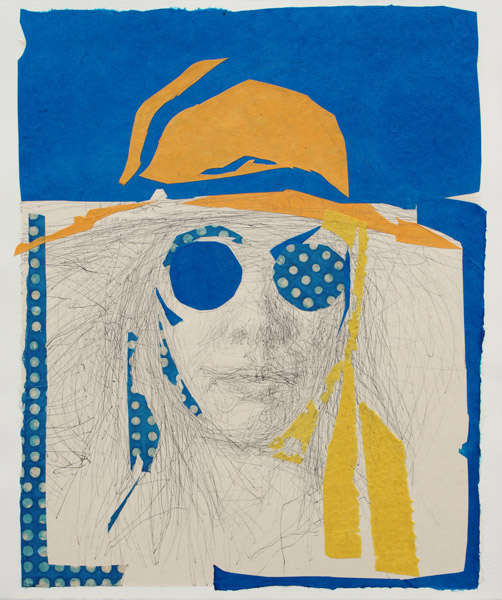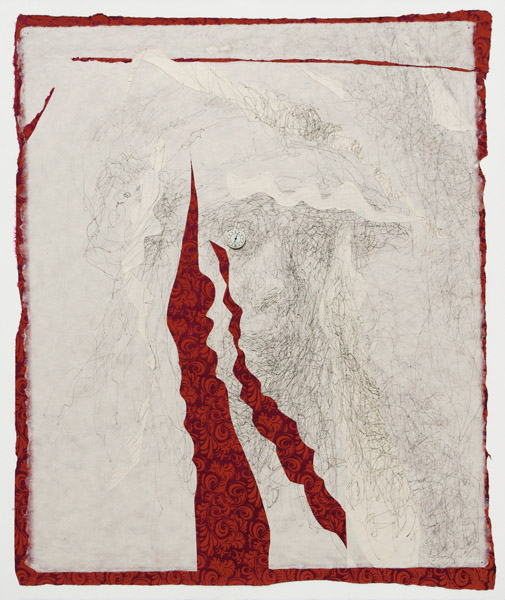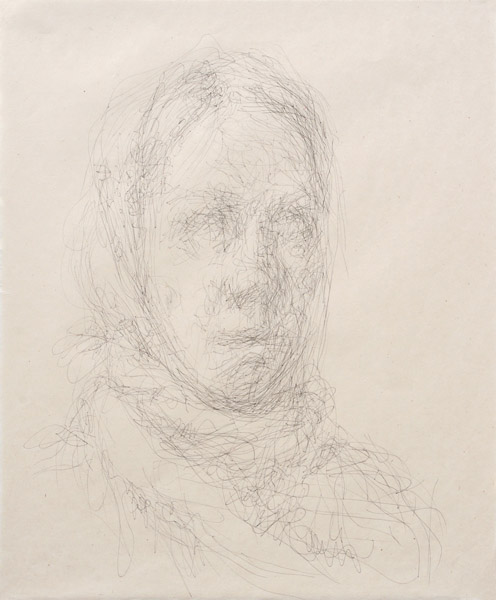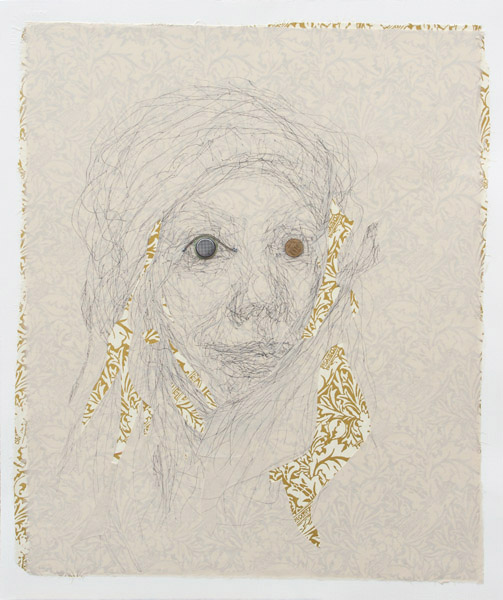I was looking at a Chagall book with three-year-old Polina, and we
stumbled upon a painting in which the trees grow sideways. She said,
mommy, turn the album. [show more]I did, but then the trees on the other side
started to grow upside down. "I guess," said Polina after some
thought, "he wanted to make it funny."
In her new series, "Masks and hats", Maria Kazanskaya "wanted to make
it funny" just like Chagall did: just as he turned his forest this way
and that, so Maria wanted the same face to appear each time on a
different background, in a different medium, now with a long nose, now
with a short one, now in a scarf, now in a hat---the funnier the
better. The artist's face is her favorite toy, a set of make-believe
armies always in the midst of battle. Maria has fearlessly sacrificed
her face to her own hunger for meaning and liberation.
This series has some initial uncertainty, instability in its hurtling,
thin, frightened lines. There's some brittleness, broken monologues,
quotations from "Flowers", a series of paintings in which flowers are
more individual than people. There are serene glimpses of nature,
which must be Maria's sister---that's how familially she paints water
and rocks, trees and sand; though in "Masks" the trees are
superimposed, netlike, on her face, the water sparkles here and there
in her eyes. And in culmination, self-assured chords of color,
punctuated by screams about the pointlessness of all our efforts.
Paintings are located in space; they speak of space. It's harder to
speak about time, though many things have been said about it by many
people. It seems like the whole world draws, paints, designs websites
and apartments. All China and many elsewhere sew beautiful dresses.
The Library of Congress stores tens of millions of books.
But talent, real talent is still rare.
Maria Kazanskaya is one of a select few.
This is an artist's thoroughly honest look at herself, time and space.
Time, here, means life, as lived up until the very minute of the
Masks' creation. Just as a poem is the shortest path traversed by a
thought or feeling, so these masks, visual poems, are the most
condensed way of recounting time, of developing the artist's thoughts
about it. Surrounding the face, you see out-of-circulation banknotes,
coins, tickets, buttons from forgotten possessions. A button speaks
about something lost, about the impermanence of things and of those
who wear them. Soviet money, which can no longer buy anything, speaks
of the unique experiences of the survivors of global cataclysms:
revolution, collapse, migrations of individuals and nations.
Dislocations, relocations, transformations of familiar spaces.
Space, for Maria, is the same kind of question without an answer, an
open wound, a rupture with Russia, with the world as she understood it
in her youth. A world in which there existed a constant friction with
her surroundings, a must for any artist; an agonizing society turned
into a fertile creative environment. Separated from her homeland, the
artist is robbed to a degree of her vitality.
But there is also the joy of being a stranger. In a foreign land, in
foreignness, you can hide, forget, get away from yourself, and find
yourself anew.
The joy of foreignness is just as bright as its bitterness is bitter.
The joy of the Japanese paper that flaunts the face so festively; the
joy of a new land, the discoverer's joy of blue and yellow, water and
sun, shading that same face. The joy of an overseas vacation, of a
yellow hat, dark sunglasses---with a patch of polka dots, a childhood
memory: the sea, a bucket, the sand, a tiny dress. And all of a
sudden, amidst the torn fragments of colorful paper, on the same face
there's a thread, some foreign stamps, a bottle cap from imported
beer. "In a black glass bottle from imported beer..." This song
sounded comfortable in a familiar, predictable world, where we weren't
responsible for anything; the cap hangs on its thread fearsomely, like
a scab torn from the face, a cap from an utterly, irreversibly foreign
bottle.
Somewhere is a place whose flesh we are torn out of, like buttons
hanging on the thread of fate.
Time and history don't end with the cataclysms of the last decades in
Russia or even all of Russian history. In a pencil self-portrait with
a wrapped-up face, we discern Rembrandt with a bandaged face, a face
which was always so unsettling when it stared from the page or from a
museum wall: is he sick? Is he deaf? Sick, deaf, lost: no true
artist has a cloudless biography, they're all wrapped up in shreds of
their fractured lives, ruptured time, disintegrating space.
So other masks disintegrate, sprawl apart: black and white, with
bewilderment and fear in their wide-open eyes. Another millimeter,
and these eyes will burst open, dripping; their radiance will turn to
tears.
Colors don't clear up the essence here, they muddle it. They change
the face until it's barely recognizable, surrounding it with more and
more distant associations. Azure eyes? Bright red cheeks and lips?
Golden hair? It's saccharine in an almost Renoiresque way, as if
dripping with venom. What is this: a quotation in the postmodern
manner? A deconstructivist's dry laugh? No, she's simply trying to
look in that particular way at herself, and thus also at time and
space, as seen right now. And another face, a sharp oval over a
thousand thin lines: the pencil drawings of the old masters, with
their soft, noble lines, suddenly gone over with a marker.
"Masks and Hats" is an unexpected turn in Maria Kazanskaya's art. As
a painter she's restless; it's not in her nature to find a single
device, a straight path to walk along calmly, perfecting the details.
After a dramatic turn like this, it would be hard to go back to the
idyllic series of portraits of her little son Nikita, of trees, water
and rocks, in which the harmony or anxieties of the world are
portrayed precisely, but not with blood, not with a wriggling lure on
a hook. How can you go back when your face is hooked, held prisoner
by hats, jerky lines, streaks and explosions of color? It doesn't
have anywhere left to hide. It burns and ripples, reflects and is
reflected. It's hard to imagine such a self-portrait in a Carmel
gallery. It's even harder to understand one of them without looking
at the others, because this new series of Maria Kazanskaya's works
speaks also about the way time distorts our guises, about the way
space multplies them, and about the way that the face nevertheless
remains, in any guise, itself.
[show less]
By Julia Nemirovskaya, translated by F. Manin

















